Master Blacksmith Francis Whitaker
Greetings, and Happy New Year.

20 years ago today, I was enroute by train to study with master blacksmith Francis Whitaker (1906-1999) in Carbondale, CO.
Francis referred to himself as “a link with the past,” as he was one of the few remaining true blacksmiths alive when the forging renaissance began in the early 1970’s.
He dedicated the last 30 or so years of his life to teaching the trade that he so dearly loved. Coupled with his vast knowledge of hand forging, he has thus been referred to as the “Dean of American Smiths.”
He began forging in 1927, initially studying with Samuel Yellin, the Polish master who had set up a shop in Philadelphia. Later, Francis traveled to Germany to study with master blacksmith Julias Schramm.
Below is a bowl that Francis made while working with Schramm.
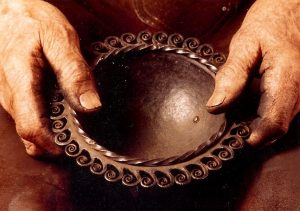
Both Yellin and Schramm had an obvious influence on Francis. He often recanted a story in which Julias asked Francis “How will you join this bowl to the stand?” Francis replied that he would “just put a few pieces in where they wouldn’t be seen.” Schramm then growled, “Oh Franz, there is never anything that will not be seen!”
These and other words would go far to shape Francis’ character, as well as his uncompromising attitude towards forging. He later adopted from Lexus the slogan: “The Relentless Pursuit of Perfection.”
Not long after his stint with Scramm, Francis set up shop in Carmel, CA. He then moved his shop to Aspen, CO. in the early 1960’s. Being civic minded and a visionary, Francis lobbied hard for both Carmel and Aspen to retain their character by keeping nationally owned chain corporations out of these areas, maintaining the charm and natural beauty of the area. Today, Aspen has a holiday, as well as a park, bearing Whitaker’s name.
Below is a railing made by Francis in his early years. (From the book “Beautiful Iron”)
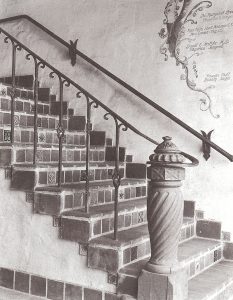
Francis also loved to ski, (he was skiing well into his 80’s) and as a result, in the early 1960’s, he invented a break-away ski binding. He sold the design to a manufacturer, who later went to patent the idea, but was thwarted as just two weeks prior, a German inventor had patented a similar binding.
While still in Aspen, Francis considered retirement, but simply hated the idea. He then approached the “Colorado Rocky Mountain School” (CRMS) and proposed that if they built a blacksmith shop to his specifications, that he would donate all his forging tools, and also teach the CRMS students how to forge. In other words, “Build it, and I will come.” The shop was dedicated in 1988.
CRMS is an elite high school for students from around the globe. It is situated on a old farm, by coincidence previously owned by Milwaukee’s own Pabst family (of Pabst Brewing fame. See “Captain Frederick Pabst Mansion” to learn more about the Pabst family.) Located in Carbondale, it sits in the midst of omnipresent Mount Sopris, one of the largest mountains in Colorado.
CRMS is charming with its dirt paths and roads, one and two story wooden classrooms and dorms, and the large, tin roofed barn, which serves as a theater.
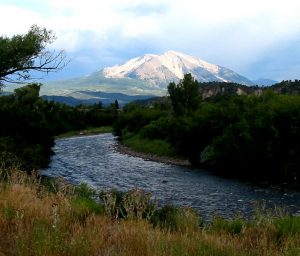
Mount Sopris, and the Crystal River, Carbondale, CO, as seen from the southeast of the CRMS campus.
CRMS also provided Francis with a house right on the campus, just yards away from the blacksmith shop, which included a deck with a spectacular view of Mount Sopris. Francis could often be found at “beer-thirty” (3:30 P.M. MST) out on his deck, taking a break and sipping one ….and only one….bottle of Coors.
My 1990 experience with Francis laid a firm foundation, as he instilled discipline, dedication, and direction for me. It was truly a life-changing experience.
That time was also exhausting, as we worked long days, and often into the night, to complete my first real architectural piece, a window grille. (shown below.)
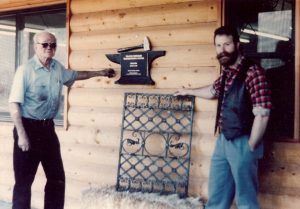
I spent another week with Francis in March of 1993 and made the garden gate pictured below. This was an exercise to make a project with as few straight lines as possible, to reinforce my bending abilities.

The other aspect of this design was to learn how to make a quatrefoil (seen in the center of the gate.) Francis developed a process for this form, which worked brilliantly. While some of the elements in this gate do not work well together, (as they are not of the same style,) it was a fine exercise in forging for me .
One morning, I was having quite a bit of trouble bending the scrolls for the gate. Francis gave me a few pointers earlier, but I was still struggling. I looked around the shop to find Francis for more help, but he was no where to be found.
A few minutes later he showed up donned in his skiing outfit. “I’m off to the slopes”, he said. (He was in his early 80’s!) Off to the slopes? I came here all the way from Wisconsin to learn from him, and he’s leaving to go skiing? I was stunned, as I needed help. How could he leave me alone like this?!
I needed a break so I went to lunch, and later returned to the task of bending the scrolls. The balance of that afternoon went fast, and for some reason, I suddenly was able to correctly bend the scrolls perfectly to the drawing. At about 5:30 PM, Francis returned, all red-faced from the cold. He came over to my work area and inspected my work. “Yeah”, he said, “I knew if I left you alone, you would feel less intimidated, and do better work. Fine job.”
What a fox.
Francis traveled the US annually, often with his beloved wife, Portia. Together, they would go from shop to shop so Francis could teach others what he knew. It was not his intent to teach his style, rather he wanted to instill in his students solid forging practice, process, and fundamentals.
It was Francis’ nature not to charge for his services as a teacher, though he might ask that one donate to his foundation bearing his name, “The Francis Whitaker Blacksmith’s Educational Foundation.”
He authored three books, “The Blacksmith’s Cookbook”, “Beautiful Iron”, and “My Life as an Artist Blacksmith”
He also traveled the globe, camera always at the ready to photograph the vernacular ironwork, and offered many stories of his travels upon his return.
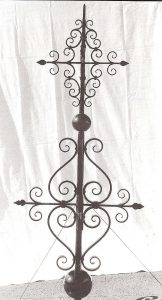
“Finial” by Francis Whitaker (from “Beautiful Iron”)
He could be found often at either the symphony or the opera theaters, as he had a love of classical music, though he forbid music of any type in the workshop.
Below are samples of some fireplace tool handles, typical of Francis’ work.
(from “Beautiful Iron.”)
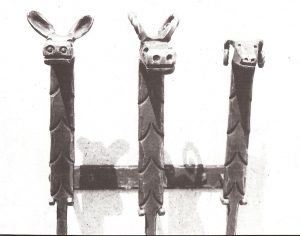
Many who have been fortunate to have known and worked with Francis knew he was easily angered by a poor approach, poor workmanship, or your hands in your pockets. But to me, his anger was of that of a grandfather, insuring that his own would follow correctly in his footsteps.
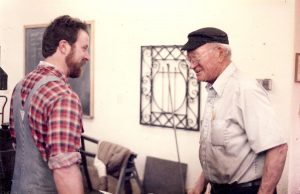
Francis taught at many workshops at various craft schools, demonstrated at countless blacksmith conferences, and in 1978 was president of the “Artist Blacksmiths Association of North America.” (ABANA)
Among his many other achievements:
Author John Steinbeck used Francis as a role model for the book “The Long Valley.”
In 1995, Francis was the recipient of the “Colorado Governor’s Award for Excellence in the Arts.”
In 1997, he was awarded the “Heritage Award”, and named “A Living Treasure”, the highest award given by the National Endowment of the Arts. The award was given to him at the nation’s White House, and presented to him by Hilary Rodham Clinton, as seen below.
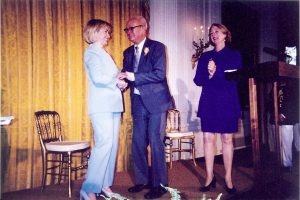
“The highlight of my life”, Francis said.
He also was honored in 1997 by the “Renwick Gallery” as they installed an iron cross made specifically for them by Francis.
Francis forged for over 72 years. I believe forging and teaching kept him young, as he was forging just five weeks before his death, at 92 years of age.
Below is one of his favorite images, showing him forging at his shop in Aspen.

Francis was an admirer of master blacksmith Cyril Colnik. In 1997, Francis provided seed money for me to produce the video production about Colnik, entitled “Forged Elegance, the Lifework of Master Blacksmith Cyril Colnik.” Francis is featured in the video.
He also provided me with a grant from his foundation to document Colnik’s work through photography in 1993.
I owe much to this man, and I am certain many others can say the same. I am privileged to have worked with him, and feel blessed to have called him my friend.
……..Dan Nauman
“Remember, I’m always looking over your shoulder.” …….Francis Whitaker, speaking to Dan Nauman at a workshop in Cedarburg, WI in 1981.
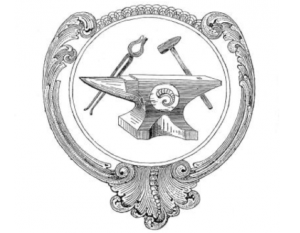
16 comments to “Master Blacksmith Francis Whitaker”
Ali Soriano - January 21, 2010
Hello and thank you for a well-written site. I am still thinking over what you write.
bighornforge - January 22, 2010
Hello Ali,
Glad you to provide you with something to ponder.
Regards…..Dan
john sullivan - August 5, 2010
I have a photograph taken by francis whiteker in 1941 and given to my unkle john oshea in carmel. they were friends. uncle john was a painter in carmel at that time. The photo is of wooden boats which were of interest to him at that time.
bighornforge - August 6, 2010
Francis Whitaker had a shop in Carmel for many years, and was also very active in local government. He essentially layed the groundwork to keep chain hotels and restaurants out, preserving the integrity of Carmel, and the surrounding area. He moved to Aspen, Colorado in about 1963. He did for Aspen what he did for Carmel. Aspen recognized Whitaker’s contributions to the area, and now celebrates “Francis Whitaker Day” annually. I don’t recall what that date is, however. There is also a park bearing his name in Aspen…….Dan
Clint - June 12, 2011
Enjoyed the article. Just getting into blacksmithing here in TN. How can I get a copy of that video. Did you make one of Mr. Whitaker?
bighornforge - July 5, 2011
You can obtain a copy of “Forged Elegance by contcting Villa Terrace Decorative Arts Museum”, whose web-site is listed at the upper right of this blog’s main page.
Robin Wood - January 9, 2013
Hi Dan. I am looking for a special set of hand-forged fireplace tools. The animal-head finials pictured above certainly caught my eye. Does your post indicate that these are “in the style of” Francis Whitaker, or that these are an example of his work? Are pieces of his available for purchase anywhere? Thanks for your reply. Robin W
bighornforge - January 10, 2013
Hello Robin…These fireplace tools shown are actual pieces that Francis Whitaker made. He made these sets based on custom orders, and not for commercial sale. Thus, they likely stay with the home or family for whom they were made. Francis passed away in 1999. It is very rare, but I have seen some of his works come up for sale, either on the Internet, or at a blacksmith’s function, i.e. a conference. My guess at a value of a three-piece wall-hung firetool set by Francis could demand $1,500-$3,500. That all said, there are many smiths nationally who can forge fireplace tools with animal-head motifs. Darryl Nelson comes to mind, who does fine animal-head work (in what he calls a “Cascadian Style”), as he is from the north-west.
Mike Poythress - July 23, 2014
I’m endeavoring to construct a shear like Francis has in The Blacksmith’s Cookbook. How, Exactly are the bits held in place. That doesn’t show up well in my copy.
christeraxe - May 21, 2015
Shear cutting edge bits would be held in place by slotted screws. Tap and die to create threads for countersunk head screws. Flush in appearance, it does not show well in the copy. Riveting would be too permanent for mounting cutting blades that may need sharpening from time to time.
Chris Axelsson
Monta Potter - April 2, 2015
I’m looking for any lanterns that were made by Whitaker. any photos? Carmel Chamber of Commerce
KenR - December 8, 2016
We purchased an old cabin in Carmel, CA last March and learned that it was Francis Whitaker’s home. We knew nothing about him or his trade but learned that he sounds like a fascinating artist who has contributed a lot to the Carmel and Aspen communities. We are honored to preserve his home in Carmel as well as enjoy his art that resides throughout the cabin.
Peter Wirth - February 24, 2017
As a kid we’d walk by Francis’s workshop every day on our way to school. I can remember the ring of his hammer forging his work, see and smell the smoke coming out of the chimney over his forge. He was always too busy to talk to us, or perhaps he wasn’t a fan of kids. He made many projects for my dad, stair railings, table, fireplace tools, etc. he was a true craftsman and artist.
bighornforge - February 24, 2017
Hello Peter…was that his shop in Aspen, CO or Carmel, CA? Likely, he was too busy to talk, as when you’re working, it’s tough to get things done and answer questions. I used to have a shop that was open to the public, and even though it was a retail shop, I kept working when folks walked in. I simply told them to let me know if they needed any help. As for kids…since they were likely not going to buy anything, I opted to work instead of engage them in conversation.
Peter Wirth - February 24, 2017
It was his shop in Aspen. It was quite large if I remember correctly. He had a lot of work as he was always out working. His shop was fairly exposed to the public, partially covered but mostly outside, I think. Those were the quiet days in Aspen. My sister still has one of his large dinning tables with a glass top on it, absolutely beautiful.
Carol Cofer - October 8, 2019
My husband and I skied in Aspen with Francis and his wife, Portia, for over 30 years until a year before his death. He taught us much about the mounains, snow and skiing. He was an expert and he led us uphill and downhill on territory we never would have tried by ourselves. We had the opportunity to view his work, his forge (The Mountain Forge), and his home, as he loaned it to us for a month while he and Portia were traveling. He always sent us journals of their trips. Portia was a fine cook and we enjoyed many meals with them in their home. I loved being in Aspen and enjoying their hospitality, friends, and skiing.
After Portia died, Francis, my husband and I took some of her ashes up to a favorite ski run and scattered them under her favorite tree, had a sip of brandy out of Francis’s flask, and poured a little on the ground under the tree in Portia’s memory. A Whitaker family friend took the rest of her ashes to Russia, where she was born.